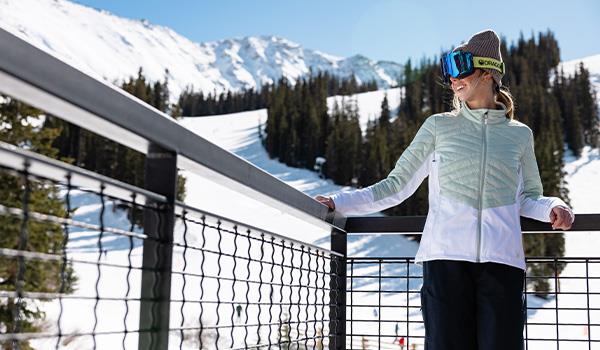 How To: Dress for Skiing
How To: Dress for Skiing
How to Dress for Skiing: Tips for Layering Under Snow Gear
Posted
by
Bianca Chang
on Tuesday, April 9, 2024
A guide on what to wear when skiing, snowboarding, and other activities out in the snow.
The key to staying warm when out on the snow is layering. By wearing a few layers you can remove, you can easily adjust your temp to stay warm and comfortable throughout the day as conditions change.
The Key is Layering
Base Layer
The base layer is a thin layer that is closest to your skin. When skiing, we tend to work up a sweat on the downhill and can get cold when stagnant on the chairlift. By choosing a breathable, moisture-wicking baselayer, we can stay comfortable throughout the day.

Also referred to as long underwear or thermal underwear, moisture-wicking baselayers are essential as they move moisture away from your skin by allowing any perspiration to easily move throughout the fabric.
Baselayers made from a synthetic blend are a good moisture-wicking choice. For ultimate warmth and breathability, merino wool baselayers are the best choice as they do a great job of insulating even when wet.
Avoid cotton next to your skin as it tends to hold on to moisture, making you cold quickly.
The goal of wearing a baselayer is to keep you dry and provide some warmth. The mid-layer is to insulate and maintain your body heat.
Mid Layer

A mid-layer could be a fleece quarter-zip, a lightly insulated pullover, or a down jacket worn over your base layer.
Some ski jackets may already be fleece-lined or have some sort of insulation, so consider that along with the conditions, you’ll be skiing when choosing the right mid-layer.
Check out some of our favorite mid-layers for men here and women here.
Outer Layer
The last layer is your outer layer or ski jacket. When choosing an outer layer it is important to choose one that is water and windproof to protect you from the elements as you're out on the slopes. For the outer layer, you have the choice of a shell or insulated jacket and pants.

A shell has no insulation. With proper layering, you can stay warm in a shell jacket and take advantage of the versatility to add or remove layers for the ideal warmth as the conditions and your activity level change such as backcountry touring. A shell can also be a great choice if you tend to run warm or if you are looking for a jacket that can be used in the early season, dead of winter, and spring skiing conditions.
As mentioned above, insulated jackets and pants may be fleece-lined, have synthetic insulation, down insulation, or a mixture of all these. This is a great option for those who tend to run cold or want to reduce the number of layers.
For additional warmth, try a bib. Bibs provide your core with a bit more warmth since they come up higher than pants. They also provide more protection from the snow, wind, and other elements from coming up the back of your jacket.
Helmet and Goggles

A properly fitted helmet and goggles are not only imperative for your safety but are also important for warmth and protection while on the mountain.
Helmets have a liner inside to keep you warm along with different ventilation options so you can regulate your temperature throughout the day. Some helmets use merino wool in their liners to keep you extra warm. Some have vents that open and close depending on the conditions.
Pairing a helmet with properly fitting goggles will help keep snow, wind, and the elements out of your face. Goggles also play an important role in protecting you from UV rays that are stronger as you increase in elevation.
Accessories

Gloves, Mittens, Socks, and Neck Warmers
When it comes to keeping your hands warm, gloves provide you more dexterity for your fingers to move freely while mittens keep your hands warmer as your fingers are all in the same compartment.
For additional warmth, try adding a glove liner under your gloves or mittens. Just like a baselayer, glove liners provide additional warmth and protection from the elements if you find yourself taking your gloves or mittens off to adjust zippers, use your phone, or help little ones.
The same rules for baselayers apply when choosing socks. Choose a sock that is moisture-wicking and comes up higher than the cuff of your ski boots for comfort and warmth while at the mountain. Ski socks also come in different thicknesses and different amounts of cushion to provide added warmth or comfort in specific areas.
Other accessories to consider may be neck warmers, balaclavas (aka ski masks), or a thin cap to wear under your helmet for additional warmth.
The key to staying warm while on the mountain is to stay dry. By dressing in layers and choosing pieces that are effective at moving moisture away from your body and trapping heat when needed, you can stay comfortable all day no matter where the trails take you.
Categories:
Skills & Advice
|
Ski Outerwear & Clothing
Tagged: Ski Accessories, Helmet, How To, Layering, Clothing